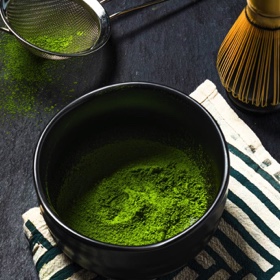Ingredients
1½ teaspoons ceremonial-grade matcha powder
1 cup hot water (175 degrees), divided
Description
Cultivated in Japan, matcha is a powder made from green tea leaves that are shaded during their growth. This increases the rate of theanine production (an amino acid also found in mushrooms), which gives matcha its characteristic umami taste and determines the quality grade of matcha—the more the plants are shaded, the higher the quality. We found that adding the matcha in two stages, once to make a paste and then the rest to whisk into a froth, resulted in a beverage that had less undissolved sediment. We used 1½ teaspoons of matcha per serving because we found it to have the most complex flavor without being overly bitter, and it resulted in a rich texture. The matcha was strong and produced a thick layer of foam after whisking. Inspired by our visit to Ogawa, we created a matcha latte variation using frothed milk instead of water for subtle sweetness that can turn matcha skeptics into matcha lovers.
Directions
BEFORE YOU BEGIN
Avoid culinary-grade matcha. For the latte variation, any type of dairy or nondairy milk will work here; soy milk will yield less foam, so we recommend using an immersion blender.
Sift matcha powder into chawan or small soup bowl. Using chasen or small whisk, whisk 2 tablespoons hot water into sifted powder until dissolved. Add another 2 tablespoons hot water and quickly whisk using a zigzag motion until a thick layer of small bubbles form on surface of matcha, about 30 seconds.
Stir remaining ¾ cup hot water into matcha. Serve immediately in chawan or teacup.
Nutrition
Calories: 3 calories
